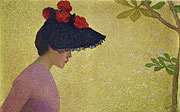
Clothing and Textiles
Clothing and Textiles

#03050310
White ground jug, attributed to the Brygos painter, around 490 BCE. The finely d...

#03050312
Limestone statue of a female worshipper playing a lyre, Cyprus, 300-280 BCE. She...

#03050367
Terracotta ash-urn in the form of a woman lying in bed, Etruscan, 510-490 BCE....

#03050369
Bronze statuette of Vanth, Etruscan, found near Mount Vesuvius, Italy, 425-400 B...

#03050370
Painted sarcophagus of Seianti Hanunia Tlesnasa, 150-140 BCE, found at Poggio Ca...

#030504 9
"Togatus Barberini", a man in a toga, exhibiting his rank and membership in a p...

#03050441
Silver ring brooch, Irish, 9th century. Brooch cast in silver before the additio...

#03050442
Thistle brooch, Irish-Viking, first half of the 10th century. The brooch consist...

#03050459
Shoulder clasps from the ship-burial at Sutton Hoo, Anglo-Saxon, early 7th centu...

#03050465
Witham triple pin set, Anglo-Saxon, late 8th century. This unusual and richly de...

#03050466
The Londesborough Brooch, Irish, 8th-9th century. The Londesborough brooch is un...

#03050467
The Strickland Brooch, Anglo-Saxon, mid-9th century. Plain gold panels enrich a...